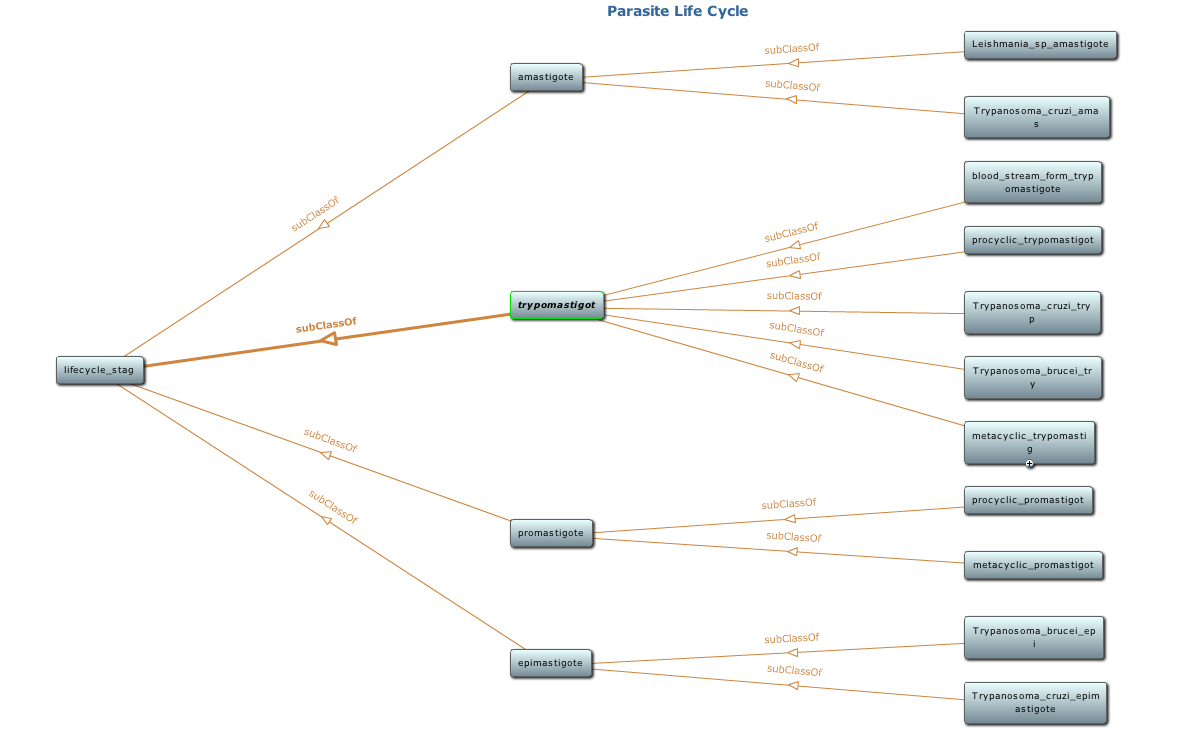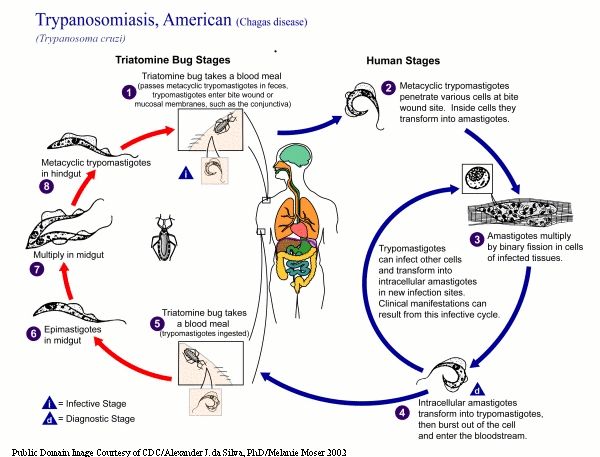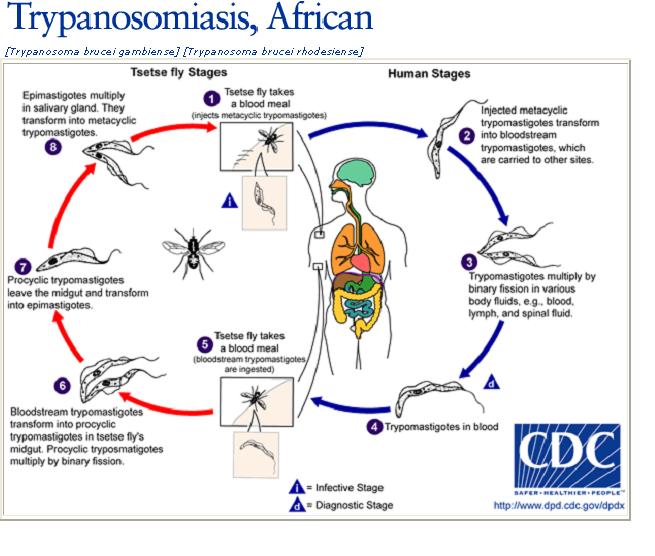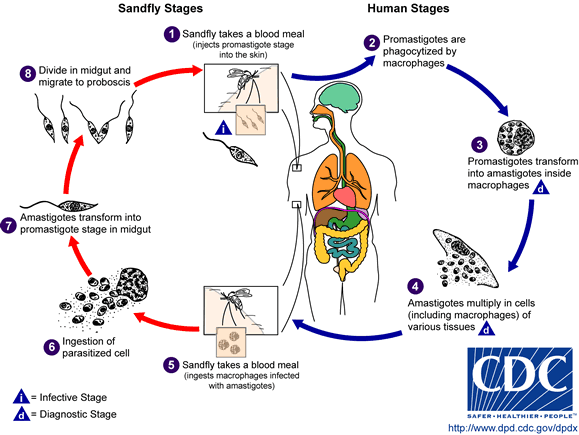Difference between revisions of "Ontology for Parasite Life Cycle"
| Line 71: | Line 71: | ||
{{block | {{block | ||
|title= ''Trypanosoma cruzi'' | |title= ''Trypanosoma cruzi'' | ||
| − | |title_background=# | + | |title_background=#ffffcc |
|content= [[Image:Trypanosoma_cruzi.gif| right | thumb | ''T. cruzi'' Lifecycle]] | |content= [[Image:Trypanosoma_cruzi.gif| right | thumb | ''T. cruzi'' Lifecycle]] | ||
| Line 80: | Line 80: | ||
{{block | {{block | ||
|title= ''Trypanosoma brucei'' | |title= ''Trypanosoma brucei'' | ||
| − | |title_background=# | + | |title_background=#ffffcc |
|content= | |content= | ||
| − | [[Image:Tbrucei lifecycle.JPG| | + | [[Image:Tbrucei lifecycle.JPG|right|thumb| ''T. brucei'' Lifecyle]] |
''[[Trypanosoma brucei]]'' is also transmitted by an insect vector, in this case the [[tsetse fly]], one of the Glossina sp. Blood stream trypomastigotes are ingested by the tsetse from an infected patient during the insect blood meal. In the midgut of the tsetse, the trypanosomes develop into [[procyclic]] forms that divide by binary fission. Some of these then migrate to the salivary glands where they differentiate into infectious metacyclic trypomastigotes. These are transmitted into new hosts during further blood feeds (Barrett et al, 2003). | ''[[Trypanosoma brucei]]'' is also transmitted by an insect vector, in this case the [[tsetse fly]], one of the Glossina sp. Blood stream trypomastigotes are ingested by the tsetse from an infected patient during the insect blood meal. In the midgut of the tsetse, the trypanosomes develop into [[procyclic]] forms that divide by binary fission. Some of these then migrate to the salivary glands where they differentiate into infectious metacyclic trypomastigotes. These are transmitted into new hosts during further blood feeds (Barrett et al, 2003). | ||
| Line 88: | Line 88: | ||
{{block | {{block | ||
|title= ''Leishmania'' sp. | |title= ''Leishmania'' sp. | ||
| − | |title_background=# | + | |title_background=#ffffcc |
|content= | |content= | ||
[[Image:Leishmania LifeCycle.gif|right | thumb| ''Leishmania'' sp. Lifecycle]] | [[Image:Leishmania LifeCycle.gif|right | thumb| ''Leishmania'' sp. Lifecycle]] | ||
| Line 129: | Line 129: | ||
<li>[[Dog]]</li> | <li>[[Dog]]</li> | ||
</ul> | </ul> | ||
| − | |||
| − | |||
;E | ;E | ||
<ul> | <ul> | ||
<li>[[Epimastigote]]</li> | <li>[[Epimastigote]]</li> | ||
| + | |||
</ul> | </ul> | ||
| + | </td> | ||
| + | <td> | ||
;H | ;H | ||
<ul> | <ul> | ||
| Line 153: | Line 154: | ||
</ul> | </ul> | ||
| − | |||
| − | |||
;M | ;M | ||
<ul> | <ul> | ||
| Line 162: | Line 161: | ||
<li>[[Midgut]]</li> | <li>[[Midgut]]</li> | ||
</ul> | </ul> | ||
| − | + | </td> | |
| + | <td> | ||
;N | ;N | ||
<ul> | <ul> | ||
Revision as of 15:16, 7 April 2010
| What is Parasite Lifecycle Ontology (PLO)? |
|
PLO models the life cycle stage details of T.cruzi and two related kinetoplastids, Trypanosoma brucei and Leishmania major. In addition, the ontology also models necessary contextual details such as host information, vector information, strain and anatomical location. All the entities in the ontology are linked to each other by explicitly modeled named relationships that will enable software applications to accurately interpret data annotated with this ontology. For example, “Trypanosoma_cruzi→has_vector_organism→triatominae”. The PLO is modeled in the W3C Web Ontology Language (OWL) standard and currently has 41 classes and 5 properties with a description logic expressivity of ALU. PLO (ver 0.1) is released through NCBO’s BioPortal repository for public use. |
|
 Snapshot of class hierarchy of the parasite life cycle ontology using Protege toolkit. Detail of this ontology is available at NCBO BioPortal |
| Organisms in PLO | ||||||
|
Here are the organisms that are covered in PLO.
|
| List of ontology classes | ||||
|
Feedback/Comments
Please add feedback/comments in Discussion Section on the top of this wiki page.


